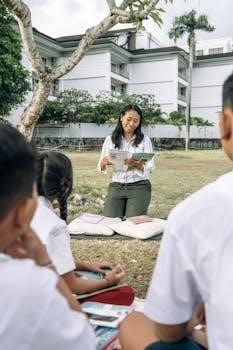What is a Flexible Instruction Day?
A Flexible Instruction Day, or FID, is an alternative approach to delivering instruction, that allows for learning to take place outside of the traditional classroom setting; It is used when circumstances prevent usual instruction․ It is approved by the Pennsylvania Department of Education․

Definition of Flexible Instruction Day (FID)
A Flexible Instruction Day (FID) represents a structured approach to delivering education when traditional, in-person instruction is not feasible․ It is a pre-approved program that allows schools to continue the educational process by using remote means, as opposed to canceling the day altogether․ An FID is not merely a day off; it is a structured learning day, where students actively engage in educational activities using online resources․ These days enable schools to maintain instructional continuity during various disruptions․ The focus is on ensuring that students continue to learn and progress academically, even when they are not physically present in the classroom․ It’s about being flexible in how instruction is delivered and ensuring students are still actively learning․ The FID program is a way to maintain a stable educational environment, even when usual conditions are interrupted․ This program ensures that educational progress doesn’t get interrupted due to unforeseen events, by facilitating learning through virtual and remote methods, making sure that students continue with their studies․
Purpose of Flexible Instruction Days
The primary purpose of Flexible Instruction Days (FIDs) is to ensure the seamless continuation of education, even when traditional classroom instruction is not possible․ FIDs are designed to prevent disruptions to the academic calendar, allowing students to keep learning without falling behind․ These days serve as a strategic alternative to traditional make-up days, which often require extending the school year․ By implementing FIDs, schools can maintain the pace of learning, regardless of unforeseen circumstances․ The main objective is to provide a structured learning environment that students can access from their homes, ensuring that educational progress remains consistent and uninterrupted․ FIDs enable educators to deliver instruction virtually, keeping students engaged in learning activities․ The goal is to maintain academic momentum, by providing effective educational experiences, even outside of the traditional classroom setting․ They are an important tool for schools seeking to prioritize continuous education․ FIDs are crucial in preventing significant learning gaps by maintaining educational consistency, regardless of external conditions, focusing on the continuity of education․

Authorization by Pennsylvania Department of Education (PDE)
The implementation of Flexible Instruction Days (FIDs) is officially authorized by the Pennsylvania Department of Education (PDE)․ The PDE has approved the use of FIDs as a legitimate alternative to traditional instruction when circumstances prevent in-person learning․ This authorization empowers school districts and other educational entities within Pennsylvania to utilize FIDs as a proactive measure to maintain continuity of education․ The PDE’s approval recognizes FIDs as a valid method for delivering instruction, ensuring that students’ academic progress is not disrupted by unforeseen events․ This initiative demonstrates the PDE’s commitment to supporting innovative and adaptable educational practices․ The PDE has established guidelines and criteria that must be met for a school to implement FIDs, guaranteeing the quality and effectiveness of remote learning․ This formal authorization provides a clear framework for schools to utilize FIDs strategically and effectively․ The PDE’s approval of FIDs reflects the importance of flexibility in modern education, providing a structured way for schools to continue learning․ It is a testament to the PDE’s recognition of the need for alternative instruction methods․

Remote Instruction on FID
On a Flexible Instruction Day (FID), instruction is delivered remotely, meaning students participate in learning activities from a location outside of the traditional classroom setting․ This remote instruction utilizes various means to ensure that students continue to engage with their curriculum․ Teachers design assignments and activities specifically tailored for remote delivery, taking advantage of online resources․ The use of virtual learning platforms is common, providing a structured environment for students to access learning materials and interact with educators․ Remote instruction during FIDs enables students to continue their education from home, ensuring that learning is not interrupted by school closures․ This approach offers flexibility in how instruction is delivered, accommodating different learning styles and needs․ Students may participate through a combination of online activities, video conferencing, and project-based learning․ The objective is to maintain educational continuity while providing a safe and accessible learning environment․ This allows teachers to continue to guide and assess student progress even when face-to-face instruction is not possible․ The remote aspect of FIDs is essential for ensuring that learning remains uninterrupted․
No Additional Make-Up Days Required
One of the key benefits of implementing Flexible Instruction Days (FIDs) is that they eliminate the need for additional make-up days when school is canceled․ This is particularly advantageous because it allows school districts to maintain their academic calendars without the disruption of rescheduling classes due to unforeseen circumstances․ By utilizing FIDs, the time spent on instruction is not lost, and learning continues seamlessly through remote instruction․ The structured approach of FIDs ensures that students receive the necessary educational content and activities even when they are not physically present in the school building․ This eliminates the need for extending the school year or having students attend classes during weekends or holiday breaks to make up for missed days․ The Pennsylvania Department of Education authorizes FIDs as a valid form of instruction, meaning that these days count toward the required number of instructional days․ This is a very important factor for the school’s overall planning․ This system helps to reduce stress for all, ensuring the school year progresses as scheduled․ The efficiency of FIDs is very valuable for all stakeholders․
Benefits of Implementing FID
Implementing Flexible Instruction Days (FIDs) offers numerous advantages to students, educators, and the school system․ One significant benefit is the ability to maintain continuity of education despite unforeseen disruptions like inclement weather or emergencies․ By using FIDs, instructional time is not lost; instead, learning is delivered virtually, ensuring that students stay on track with their academic progress․ FIDs allow teachers to design engaging assignments and activities that can be completed remotely, promoting a more flexible learning environment․ This approach also enhances students’ digital literacy skills as they become adept at using virtual platforms and online resources․ FIDs provide a valuable alternative to traditional classroom instruction, and they can be implemented without the need to reschedule make-up days․ Furthermore, FIDs can reduce stress and disruption for families and students․ The school system can also maintain its schedule․ This is very useful for everyone involved in education․ They offer flexibility in how instruction is delivered, which can be beneficial for students with various learning styles and needs․ The overall benefit is a very effective and efficient educational system․
Delivery of Instruction During Emergencies
Flexible Instruction Days (FIDs) are crucial for delivering instruction during emergencies that prevent students from attending school in person․ These emergencies can range from severe weather conditions like snowstorms or floods, to public health crises, or any other unforeseen circumstance that disrupts the usual school schedule․ Instead of completely halting education, FIDs allow schools to seamlessly transition to remote learning․ This ensures that students continue to receive instruction and complete their coursework from home, minimizing any learning gaps․ During an emergency, teachers can use virtual platforms to provide lessons, assign activities, and communicate with students, keeping them engaged and connected to their learning․ By utilizing FIDs, schools can maintain their academic calendar without the need for additional make-up days which can be difficult to schedule and arrange for․ It also provides a safe and secure learning environment for students, protecting them from any potential risks during emergencies․ The use of technology also enhances digital skills for both students and teachers alike․ FIDs help create a flexible and adaptable education system that is prepared for any unforeseen event․
Continuation of Education from Home
Flexible Instruction Days (FIDs) ensure the continuation of education from home when school buildings are closed for various reasons․ When traditional in-person learning is not feasible, FIDs enable students to engage with learning materials and continue their academic progress without interruption․ This approach is designed to maintain the flow of education by providing students with the resources and support they need to learn remotely․ Students can access assignments, lectures, and activities through online platforms, allowing them to study at their own pace and on their own schedule․ This flexibility is particularly beneficial for students who may have different learning styles or home situations․ The ability to continue learning from home not only prevents academic setbacks but also provides a sense of routine and stability during times of disruption․ Teachers can use various digital tools to connect with their students, provide feedback, and offer assistance, making sure that learning is engaging and effective․ The shift to remote instruction allows for a seamless transition and keeps students on track with their educational goals, ensuring that learning never stops despite external challenges․ FIDs help create a continuous learning environment․
Virtual Learning Platforms
Virtual learning platforms play a crucial role in the implementation of Flexible Instruction Days (FIDs)․ These platforms provide the necessary infrastructure for delivering remote instruction and enabling students to continue their education from home․ They offer a wide range of tools and features that support various learning activities, such as online lectures, assignment submissions, and interactive discussions․ These platforms can include learning management systems, video conferencing tools, and collaborative documents, creating an engaging and dynamic online classroom experience․ The use of these virtual environments allows teachers to effectively communicate with their students, provide feedback, and monitor their progress․ Students can access learning materials, participate in group projects, and receive personalized instruction, which is essential for maintaining high-quality education․ The flexibility of these platforms enables students to study at their own pace and on their own schedule, which is particularly beneficial for diverse learning needs․ Virtual platforms also facilitate communication between teachers, students, and parents, ensuring that everyone is informed and involved in the educational process․ These platforms are essential to ensure the smooth continuation of education during times when traditional classroom instruction is not possible․ They help maintain educational continuity․

Alternative Approach to Delivering Instruction
Flexible Instruction Days (FIDs) represent an alternative approach to delivering instruction, shifting away from traditional in-person classroom settings; This approach allows educational institutions to maintain continuity of learning when circumstances prevent regular school operations․ FIDs utilize various technological tools and methods to facilitate remote instruction, ensuring students can continue their studies from home․ This innovative approach enables educators to design assignments and activities that are accessible remotely, promoting learning even when schools are physically closed․ By using virtual platforms, teachers can deliver engaging lessons, provide feedback on student work, and maintain regular communication with their students․ This alternative method offers flexibility in scheduling and allows students to work at their own pace․ FIDs provide a solution for maintaining educational momentum during emergencies, inclement weather, or other unforeseen events, minimizing disruption to the academic calendar․ The use of FIDs highlights the adaptability and resilience of the educational system, demonstrating a commitment to continuous learning regardless of external circumstances․ This approach requires careful planning and effective communication to ensure students can successfully participate in remote instruction, while also maintaining a supportive and engaging learning environment․ It is an important tool․
Circumstances Preventing Usual Instruction
Flexible Instruction Days are designed to be implemented when a variety of circumstances prevent traditional in-person instruction․ These circumstances often include unforeseen events that make it unsafe or impossible for students and teachers to attend school buildings․ Inclement weather, such as heavy snowstorms, ice, or extreme temperatures, can create hazardous travel conditions that necessitate the closure of schools․ Public health emergencies, like pandemics or widespread illness outbreaks, may also require schools to temporarily suspend in-person classes to prevent the spread of disease․ Infrastructure issues, such as power outages, water main breaks, or building damage, can render school facilities unusable, leading to the need for alternative instructional methods․ Furthermore, other emergencies, such as natural disasters or local crises, can disrupt the normal school day․ Flexible instruction days provide a solution for maintaining educational continuity despite these challenges, ensuring that students can continue their learning without significant interruptions․ The use of FIDs allows school districts to respond effectively to a range of disruptive situations, prioritizing student safety while minimizing the loss of valuable instructional time․ This approach demonstrates adaptability and preparedness in the face of unpredictable events․
